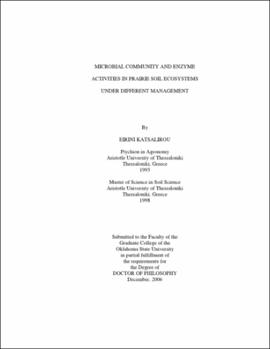| dc.contributor.advisor | Deng, Shiping | |
| dc.contributor.author | Katsalirou, Eirini | |
| dc.date.accessioned | 2013-12-10T18:04:35Z | |
| dc.date.available | 2013-12-10T18:04:35Z | |
| dc.date.issued | 2006-12 | |
| dc.identifier.uri | https://hdl.handle.net/11244/7734 | |
| dc.description.abstract | Scope and Method of Study: The aim of this study was to evaluate the effects of longterm management practices on microbial properties and biochemical processes related to C, N, and P cycling of semiarid prairie soil ecosystems. The management systems included undisturbed, abandoned from cultivation, moderately grazed, heavily grazed and cultivated soils. Soil chemical and microbial properties, enzyme activities involved in C, N and P cycling, microbial diversity and community structure were tested in surface soil samples taken from nine randomly selected plots for each treatment. The spatial variability and dependency of organic C and microbial biomass and activity were also evaluated. | |
| dc.description.abstract | Findings and Conclusions: The moderately grazed system had similar chemical properties, and microbial biomass and activity to the undisturbed soil ecosystem. More intensive grazing reduced organic C and total N. Grazed systems showed similar activities for most enzyme activities tested to the undisturbed system. Long-term cultivation decreased organic C, total N, total P, and microbial biomass and activity, while increasing the concentrations of labile nutrients. Enzyme activities were the least in the cultivated system, indicating its lower potential for C, N and P transformations, and resulted in accumulation of organic P. The abandoned from cultivation system had intermediate organic matter, microbial biomass, and enzyme activities between the cultivated and the undisturbed and grazed systems. The undisturbed soils had the most diverse microbial communities with relatively higher proportions of k-strategists, while the cultivated had the least diverse microbial communities with high proportions of r-strategists. Microbial biomass C and N were the most spatially variable, especially in cultivated soils. The spatial structure of microbial biomass in cultivated soils revealed a periodicity caused by cultivation operations. Overall, through secondary succession the abandoned soil ecosystem indicated slow recovery from cultivation, and that it can regain its capacity to sequester C and to recycle nutrients. Grazing did not degrade soil chemical and microbial properties, sustains the biochemical capacity of the soil ecosystem for nutrient cycling, and in particular moderate grazing can be a sustainable management alternative for the semiarid soil ecosystems of the Southern Great Plains. | |
| dc.format | application/pdf | |
| dc.language | en_US | |
| dc.rights | Copyright is held by the author who has granted the Oklahoma State University Library the non-exclusive right to share this material in its institutional repository. Contact Digital Library Services at lib-dls@okstate.edu or 405-744-9161 for the permission policy on the use, reproduction or distribution of this material. | |
| dc.title | Microbial community and enzyme activities in prairie soil ecosystems under different management | |
| dc.contributor.committeeMember | Fuhlendorf, Samuel D. | |
| dc.contributor.committeeMember | Zhang, Hailin | |
| dc.contributor.committeeMember | Fathepure, Babu | |
| dc.contributor.committeeMember | Nofziger, David L. | |
| osu.filename | Katsalirou_okstate_0664D_2124.pdf | |
| osu.accesstype | Open Access | |
| dc.type.genre | Dissertation | |
| dc.type.material | Text | |
| thesis.degree.discipline | Soil Science | |
| thesis.degree.grantor | Oklahoma State University | |
